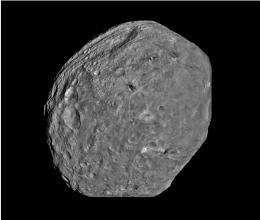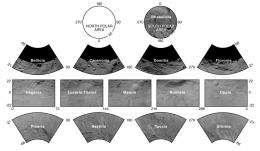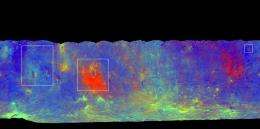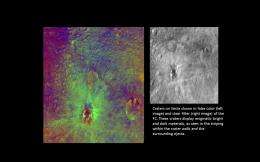Dawn at Vesta: Massive mountains, rough surface, and old-young dichotomy in hemispheres

NASA’s Dawn mission, which has been orbiting Vesta since mid-July, has revealed that the asteroid’s southern hemisphere boasts one of the largest mountains in the Solar System. Other results show that Vesta’s surface, viewed at different wavelengths, has striking diversity in its composition particularly around craters. The surface appears to be much rougher than most asteroids in the main asteroid belt. Preliminary results from crater age dates indicate that areas in the southern hemisphere are as young as 1-2 billion years old, much younger than areas in the north. The findings are being presented today at the EPSC-DPS Joint Meeting 2011 in Nantes, France.
“We are learning many amazing things about Vesta, which we call the smallest terrestrial planet,” said Chris Russell, the Dawn Principal Investigator. “Like Earth, Mars, Venus and Mercury, Vesta has ancient basaltic lava flows on the surface and a large iron core. It has tectonic features, troughs, ridges, cliffs, hills and a giant mountain. The south polar mountain is larger than the big island of Hawaii, the largest mountain on Earth, as measured from the ocean floor. It is almost as high as the highest mountain in the solar system, the shield volcano Olympus Mons on Mars.”
In mid July Dawn entered orbit around Vesta and began imaging what is possibly the oldest planetary surface in the solar system. The surface of Vesta shows the ravages of time. Many more craters are seen in the northern hemisphere than the southern because an enormous impact altered the earlier cratering record in the south. Since July the Dawn spacecraft has been moving ever closer to Vesta, moving into a polar orbit to look down on every square kilometre of the planetary surface. In mid August it entered Survey orbit at 2700 km altitude and mapped the entire sunlit surface with its framing camera and Visible and IR mapping spectrometer.

“We completed that phase at the beginning of September and since then have been moving the spacecraft to its next mapping orbit, the High Altitude Mapping Orbit at 680 km altitude, which it reached on the weekend. Over the coming month it will return complete coverage of the sunlit surface with a resolution of 60 metres,” said Carol Raymond, Dawn’s Deputy Principal Investigator.
A new coordinate system has been defined for Vesta because the old coordinate system, based on low-resolution telescopic data was wrong by almost 10°. Even with data from the Hubble Space Telescope it had been difficult to determine Vesta’s rotation axis. After defining the coordinate system, the team has begun naming the prominent features.

“The head of the mapping spectrometer group, Angioletta Coradini, suggested that the large southern crater on Vesta be called Rheasilvia after the mother of Romulus and Remus and the mother of the Vestal virgins. The IAU has accepted this suggestion, as well as the names of thirteen Vestal virgins for craters that define quadrangles. The team is now measuring the craters, identifying ridges, hills and lineations to have the sunlit surface totally mapped by the end of the year,” said Russell.
The Dawn framing camera, built and operated by the Max-Planck Institute for Solar System Research (MPS), in cooperation with DLR, Berlin and the Technical University of Braunschweig, provides more information than the black and white images suggest. The framing camera is equipped with seven colour filters in order to collect spectral information. This makes it possible to highlight certain spectral features in false colour maps that would not be visible to the naked eye. The surface of Vesta shows striking diversity when viewed in false colours that are ratios of light intensity at different wavelengths. These false colour variations are diagnostic of different surface materials. The spectral variations are particularly strong around craters. Where the clear filter images show bright and dark features, the colour data show these are also comprised of different materials, likely excavated by the impacts.

“One of the most prominent colour features on Vesta’s surface is associated with a 40 km diameter crater near Vesta’s equator. It shows a spectacular red ejecta blanket to the south. We believe that this eject blanket, which covers only a half-circle, has been created by an impactor hitting the surface on a trajectory of oblique incidence,” said Andreas Nathues of MPS.
Dawn also carries a Visible and Infrared Mapping Spectrometer (VIR), provided by the Italian Space Agency, and managed by Italy's National Institute for Astrophysics (INAF-IASF), in collaboration with Selex Galileo, where it was built. Data from VIR reveal the composition and nature of the materials on the surface of Vesta.
“Data from different wavelengths can be combined to investigate different types of materials. The colour variations seen by VIR suggest variability in the surface mineralogy. Brightness variations seen in visible light can be compared with the thermal emission at five microns to determine the source of the variations. Measured surface temperature variations range from 240 to 270K,” said Maria Cristina de Sanctis, of INAF-IASF.

The difference in the number of craters between the two hemispheres is also striking. By counting the number of craters per unit area in different terrains, the relative ages of these different terrains can be obtained. Preliminary results of these crater age dates indicate much younger ages for areas in the south versus the north, as young as 1-2 billion years old. So far, the oldest ages, in the northern hemisphere, are younger than 4 billion years old, which is an unexpected result given that meteorites from Vesta have ages of 4 billion years. However, the crater counts will be refined with the more detailed data to be collected, and the assumptions about how the impact flux decays with time will be evaluated, so the absolute ages are preliminary.
“Vesta’s surface has a surprisingly complex set of structural features, including the massive south polar mountain, steep slopes, deep troughs, and sets of curved lineations that appear in some cases to be associated with slumps, or landslides. The variation in Vesta’s brightness as the sun angle changes indicates that the surface of Vesta is very rough, causing the light to scatter. This roughness could be at the scales of surface features or at the scale of individual minerals in the rocks, or both. Vesta’s roughness is larger than most asteroids in the main asteroid belt,” said Raymond.
“Tragically, the leader of the VIR spectrometer team, Angioletta Coradini, passed away last month but not before she got to see this amazing alien world and to see her suggestion to name the craters of Vesta after the Vestal virgins fulfilled. We are going to miss very much this amazing woman, brilliant scientist and esteemed leader of the VIR investigation,” said Russell.
Provided by Europlanet





















